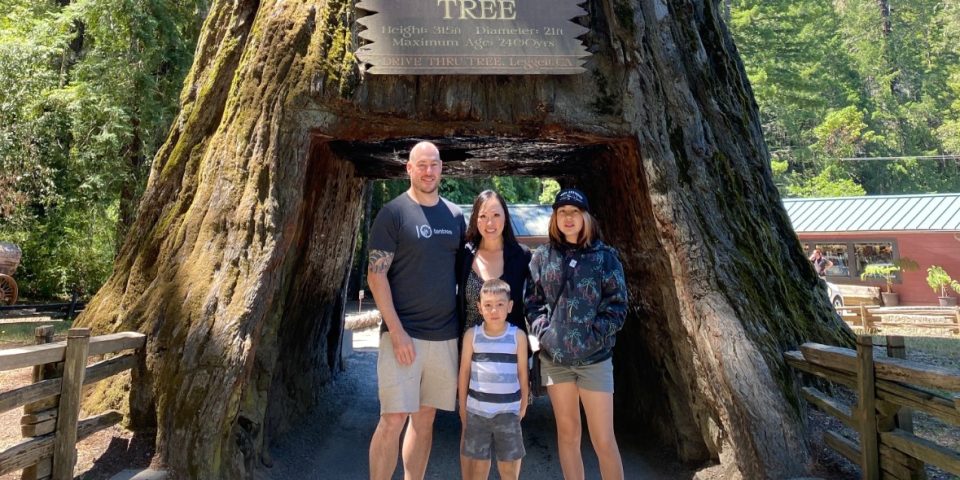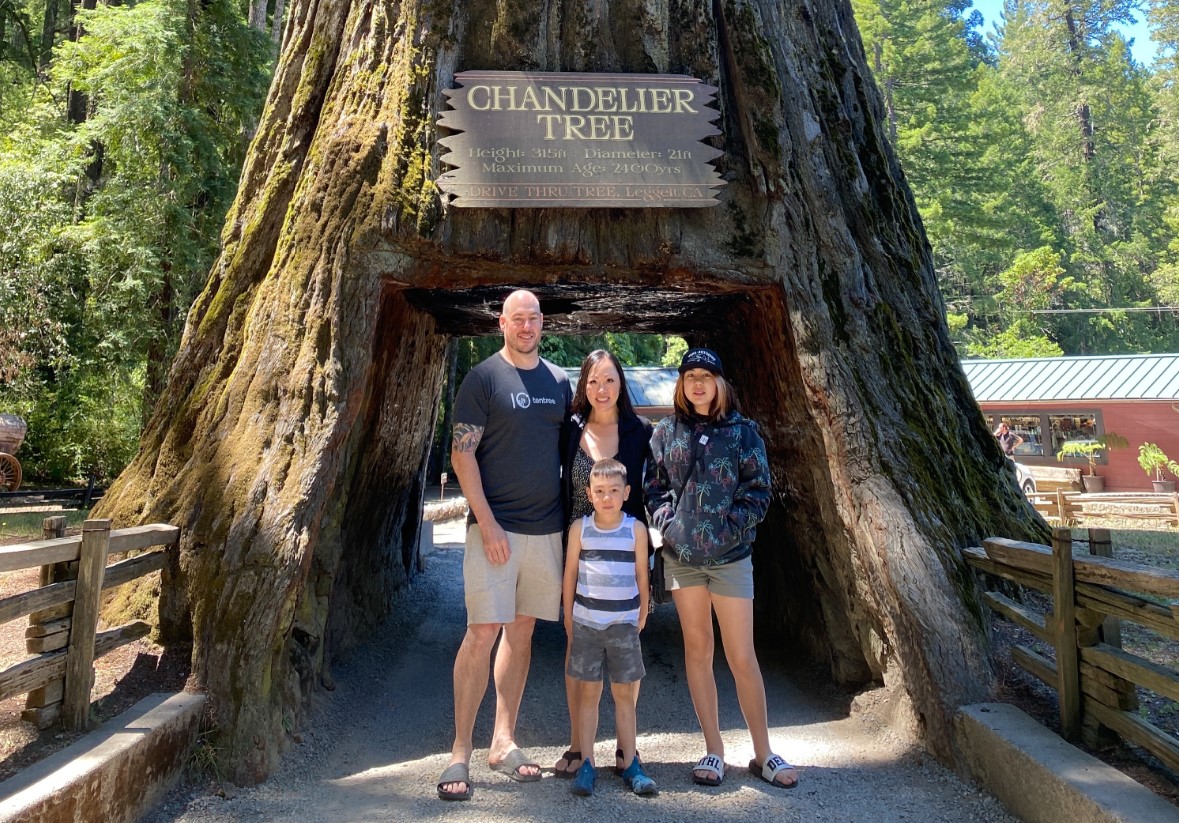Kids & Tech: Sean Herman of Kinzoo on Digital Literacy and Data Privacy
General

![]() Posted by: Kosciusko Connect
2 years ago
Posted by: Kosciusko Connect
2 years ago
At Kosciusko Connect, we take a vital step beyond quality, high-speed internet into the conversations that matter to our community’s families. As we provide fast fiber internet for Kosciusko County homes, we strive to provide platforms for success and safety while you navigate your corner of the digital world.
Sean Herman is the founder and CEO of Kinzoo, a brand that delivers safe, engaging apps designed for kids. Kinzoo values transparency and connection through its three platforms: Kinzoo Together, a video chat app, Kinzoo Messenger, a kid-proof messaging app, and Kinzoo Adventures, a space for video animation and storytelling. We sat down with Herman to talk about the relationship between children and technology and how parents should go about navigating that world. 
When you founded Kinzoo, what was missing from the digital world at the time that pushed you to explore your own options for a trustworthy solution?
SH: I knew technology was going to be part of my kids’ lives as they grew up, and reconciling that with every single app or game my daughter tried didn’t feel right. We weren’t anti-technology by any means, but we tried to maintain a healthy balance.
Once, we had just moved cities, and I was looking to keep her connected with her grandparents and some friends she had moved away from. I surveyed the market and only found one solution that came from Facebook: Messenger Kids. That was a full stop for me. I wasn’t a Facebook user, and it didn’t feel right to put my then seven-year-old daughter on a Facebook platform and expose her to that kind of business model. That’s when I realized that there was a lot of white space, and nobody was solving this problem.
I founded Kinzoo on two fundamental beliefs: 1) technology isn’t going anywhere, and we as parents need to find better ways to incorporate it, and 2) I felt that parents were going to be looking for solutions outside of Facebook and anti-Facebook sentiment would continue to grow. People would be looking for solutions that were privacy-first, that didn’t have an advertising business model, and that put the needs of users above those of advertisers.
How do you balance having safe tech boundaries with encouraging digital literacy, so kids can be equipped to navigate technology as they grow up?
SH: The tagline on our website is “flipping the script on screen time,” and we believe that there is good screen time out there. We had to define what that meant for us. The pillars we came up with were that technology can be additive when it’s connecting; if it’s helping children explore creativity, like finding out new things about the world and being able to explore within a walled garden; and cultivation, or being inspired by learning new skills and new interests.
That’s how we ended up defining good screen time – we rallied around it and call it our three Cs at Kinzoo. The fourth C is consumption, and that’s what most parents are used to. It’s not that screen time has to be eliminated, but I think it can be managed a little more tightly.
I send a newsletter every two weeks, and we talk a lot about business models and design and how it’s all interwoven. The problem with trying to retrofit adult platforms back into kids’ platforms is that those platforms are built to maximize two things: growth and engagement. Virtually all of them have an advertising model bolted onto them.
The advertising model works simply: the more time people spend on your app, the more ads you can put in front of them, the more money you make. Those kinds of business models lead to children potentially being shown things that aren’t right for them, or there are privacy impacts to it, but also the way they’re designed – persuasive design, dark patterns, endless feeds, algorithms that are meant to keep us glued to the screen. We’re just as susceptible as adults. We have more agency to understand what’s going on, but when it comes to kids, we can see how those kinds of designs can become problematic very quickly.
It starts with the business model. We’ve designed Kinzoo from the ground up around child privacy and the legislation and regulations around kids. We’re also leaning into the age-appropriate design code.
Tell me about how the Video Chat App, Kinzoo Together, became a part of Kinzoo.
SH: We actually acquired Kinzoo Together, and it joined the family. We had gotten to know their founder, Enrique, and there was an obvious overlap in our values and the way we view the world. He’s also a dad. His founder’s story is remarkably similar to mine. Enrique lives in Spain, and his children’s grandparents were living in Germany, so he was looking for a way to keep them in touch.
With younger kids, like 5 and under, video calls usually aren’t a high-quality experience. The problem he was out to solve was, how do you create an engaging experience that still allows a deep connection to happen? The solution was reading together and playing video games, and not with the goal of keeping eyeballs on it for as long as possible, but to create moments between families. That was his driving force and ours.
We were looking to bring more expertise into the company, and he happened to be trying to figure out what he wanted to do next. He joined Kinzoo as the CTO, and we continue to invest in it together as we build.
We’ve recently introduced a new type of experience that we call Topics, which combines reading with games. We’re also looking at exciting new features. At the end of the day, it’s all about how to create these sparks between family members.
As a storytelling animation app, Kinzoo Adventures takes the Kinzoo brand in a new direction. How did that come about, and what is the goal of the Kinzoo Adventures app?
SH: Kinzoo Adventures was a passion project. I had originally thought of a story builder that might work inside of the Messenger, giving children the ability to build basic stories. It evolved into something more robust, so we decided to make it a separate project. Like most things at Kinzoo, the inspiration started with some of the platforms my daughter was using where I didn’t love the app she was using. Fundamentally, I was looking at how she was using it, and I saw this little storyteller that wanted to come out. When I looked at that, I thought we could improve the experience, not only for the kids but also for the parents who might not like aspects of other apps.
We got really excited! Kinzoo Adventures clearly leans on our pillars: creativity, cultivating skills in basic animation and storytelling, and connection. Often, kids will create a story, and the first thing they’ll want to do is share it with their parents, sibling, or friends. It’s a new product getting its footing here in the market.
We want to arm kids with ways to create things, and with Kinzoo Messenger, they have a platform to easily share those things with others in a safe and private way.
Why is digital literacy essential for this generation of kids, and how can parents go about educating them about it?
SH: Digital literacy is like critical thinking, and it’s a skill we’re losing as a population. Increasingly, we’re looking to social media to get our news and opinion on things. We haven’t done a good enough job of stepping back and understanding that there are certain kinds of content that engage more. There are extremes, and the truth usually lies in the middle.
When I first started the company, I heard of a lot more people trying to hold off on technology as long as they could, like no iPad until their kid was 10 or something. Increasingly, there’s a positive trend based on the belief that technology isn’t going anywhere. It’s about how we introduce it, not if we introduce it.
I think Kinzoo Messenger is unique in how we intentionally try to have parents and children on the same platform. This allows us to try to prompt conversations between the two and build a foundation of knowledge together. We want to help the parent not just give rules to follow but be actively involved, talk it through, and spark conversations about what it means for things like making sense of the news.
What is something that parents don’t often know about kids and technology?
SH: Free isn’t free. There’s really no such thing as a free platform. We’re getting through this period of expectation of things to be free, and we’re starting to understand that there are trade houses, and the trade houses are quite sizeable. That’s amplified when it comes to kids.
Holding off technology as long as you can is a misconception because children are exposed through their friends and other ways. It’s about arming them to make good decisions for that moment when they’re on technology and approached by a stranger in inappropriate ways, or if they’re on technology and they find themselves feeling sad, anxious, or like everyone else has a better life than they do.
The earlier and the more you can discuss it, you hope to prompt conversations where they can start to recognize these things and understand that not all technology use is positive. Technology has been a massive positive force in my life, and in my kids’ lives, but that doesn’t mean it won’t come with risks. The approach of holding it off can mean your children will be ill-prepared for things they’ll inevitably encounter.
We’re trying to build Kinzoo to be a sustainable company. That means we’re not going to sell data, so we have to find other ways to generate revenue for the business. Ultimately, we’re going to need parents and families to buy into the greater purpose of what we’re doing and understand that anything they pay is an investment in their children’s safety and privacy.
How can parents sit down and have difficult conversations with their kids about technology in a way that prompts responsiveness and openness?
SH: Above all else, just have the conversations. One of my advisors is a former police officer and now lectures students in schools about digital literacy. I like to cite what he says: 99% of what your kids do online and want to do online is perfectly safe and good-spirited. The 1% does potentially have big-time consequences. It just becomes about having conversations and not pretending these things don’t happen. Don’t try to wholly avoid technology because, as I said, children are probably going to be exposed to it one way or another.
My daughter is on Roblox, and a stranger tricked her out of some Roblox. It was a very upsetting experience for her, but we were able to take that negative and turn it into a positive. It wasn’t worse than it was because we had put up the guardrails that we were comfortable with on the platform. It was a good learning experience for her, and we were able to talk about it.
I discuss a lot of her early experiences with technology in the book. When bad things happen online, it’s important to say, “Why did it happen? What can we learn?” instead of “Okay, you’re not using the iPad anymore.” Some parents take the technology away when a bad thing happens. If you take that approach, you might miss out on these learning opportunities.
I’m far from perfect, and I’ve made a lot of mistakes along the way, but it’s usually in the vein of trying to lean into technology. As we experience bad things and think about how to prevent them in the future, we should focus kids’ usage on the positive aspects, which I think are many.
At Kosciusko Connect, we offer Guardian, the network security and parental controls tool. But we also want to help provide guidance for parents when their child comes to them with an app request. What kinds of features should parents look for when choosing whether to download an app for their child?
SH: Platforms like yours are incredibly helpful. All parents should use them to some degree, to set time limits, boundaries, and okaying downloads. That’s a great start, but when you get into the apps, there’s more to it than that.
The first thing I look at is the business model – how does this app make its money? Typically, it’s one of four ways: you pay for the app up-front, you subscribe to the app, you buy things from the app, or you’re not sure. The ones where you’re not sure are typically littered with ads.
My advice to parents is to understand the way advertising-driven apps work – the more ads they can show, the more money they make, and the more time your child spends in that app, the more ads they can show. That’s where you typically see things like persuasive design, whether it’s keeping streaks alive, algorithms, or endless feeds.
Watch out for in-app purchases, dark patterns, and when it’s easy to accidentally make big purchases without age verification. Try to find the apps that you like, the ones that when your child is on them, you don’t have that anxiety in your stomach. If you find apps like that, be willing to part with some dollars and support those apps. We’ll see a better ecosystem of kids’ apps when we, as parents, are willing to make some of those investments.
That doesn’t mean I want to pay for 100 apps. If my child really loves to use an app, and it’s an app that I’m happy with them using, I’m much more willing to pay than I was 5 years ago because I’ve thought more and more about this and what it means down the road.
Your book, Screen Captured, is marketed as a non-alarmist resource for parents. How does a non-alarmist approach aid your mission to help parents navigate the digital world with their kids?
SH: It starts with that belief that technology isn’t going anywhere and there are plenty of good uses for it. One of my favorite blog posts I’ve ever written was when there were two groups of PhDs in conflict on Twitter about the effects of screen time. One side likened it to being as bad as heroin use, which I thought was ridiculous. The other side said it was as harmless as a potato.
The point of the blog post I wrote was that the truth is somewhere in the middle. Arguing the extremes tends to get better engagement on social media, so you can understand why they’re doing it, but what I said to the authors of those studies was, “You’re really putting parents in a tough spot here because any parent reading this has to pick a side. Either their kids are not allowed tech whatsoever, or tech is harmless as a potato.”
If you’re researching screen time, it’s very easy to find plenty of content that argues the extremes. But I think the truth is in the middle, and what we’re trying to be is that reasonable voice in the middle that tries to arm parents with practical advice. We try not to be prescriptive in the way that we speak. We don’t believe in managing screen time to the clock. To us, it’s much more important what they’re doing and how they’re spending that time. We’re trying to arm parents with different ways of thinking about screen time and getting some of that fear factor out of there.
Going forward, how would you advise parents to conduct their own research and learn more about the relationship between kids and tech?
SH: There’s not a lot of conversation about it, and there should be more. We’re proud of the content we create, but we’ve found that the conversations aren’t happening enough. If you’re searching for screen time or how to handle these situations, cross reference. If someone is citing a study, go see who wrote that study – is it reputable, academic, and peer-reviewed? How big are the sample sizes? I’ve seen countless that conclude that screen time is awful, but they only surveyed 30 people. You’ll see that people have a narrative and want to feed it.
I’ve read books that range from the extremes of “Screen time is causing a mental health crisis” to “Screen time is perfectly fine, and we’re overreacting.” Think critically, research, cross reference, and see if the experts are great voices in a space that’s doing great things.
At the end of the day, screen time is among the top three factors that parents are thinking about actively. There’s no research to support hard and fast rules. For now, it’s a matter of thinking critically about the relationship that you want your children to have with technology, and what you want them to get out of it. Then seek platforms that align with that.
If you enjoyed this Q&A with an industry expert, there are more to come! Stay tuned for next week’s Kids & Tech interview with a local health educator.
Call Kosciusko Connect at 574-269-0327 to learn more about Guardian, our network security, and parental controls tool!
Further Reading:
Back to School Tech for Each Grade Level
Categories:
About: Kosciusko Connect
You May Be Interested In:

How Does Arlo AI-Powered Motion Detection Work?
4 months ago by Laura Seney

Top 5 Things to Look for in a Security Camera System
6 months ago by Kosciusko Connect

The Future of Connectivity: Why Fiber Internet is Revolutionizing Warsaw, Indiana
8 months ago by Kosciusko Connect

Easter Coloring Contest
1 year ago by Kosciusko Connect
Ready to Get Connected?
Do you have questions or need assistance? Our customer service team is just a call or click away. Contact us today for personalized help!